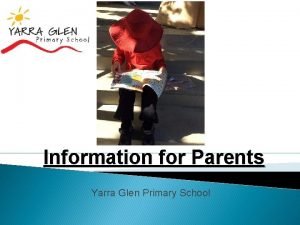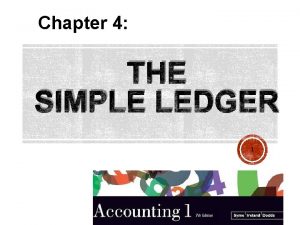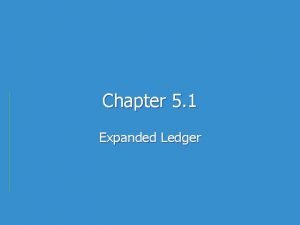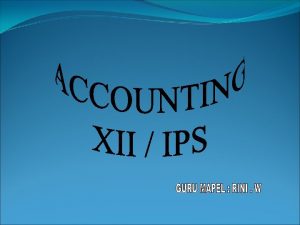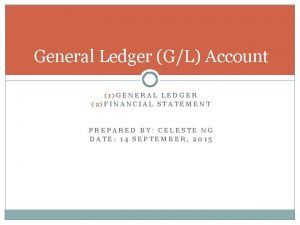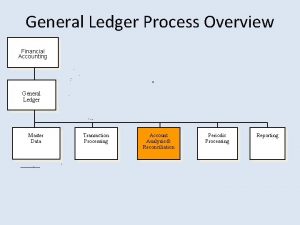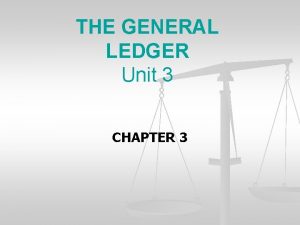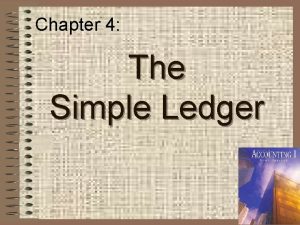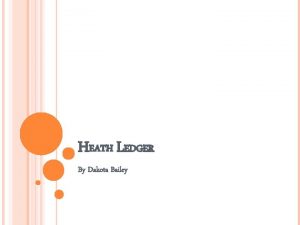LEDGER INTRODUCTION Ledger is the principal or primary



















- Slides: 19

LEDGER INTRODUCTION Ledger is the principal or primary book of accounts. It is the most important book in accounting system. It contains all the accounts (assets, liabilities, capital, revenue, and expenses) to which the transactions recorded in the books of original entry are transferred (posted). In ledger the information is classified by nature and relevance. It may be maintained as bound book or loose leaf sheets or (in case of computerized accounting) in floppy diskettes. DEFINATION OF LEDGER “A ledger is the most important book of accounts and is the (final) destination of the entries made in the subsidiary books. ” FEATURES OF LEDGER The main features of ledger may be stated as follows: 1. ) It is the principal or primary book of accounts. 2. ) The transactions are classified under appropriate heads , called accounts. 3. ) The accounts contain the condensed record of all the related transactions. 4. ) It is the basis of preparing the final accounts. Hence, it can not be avoided. NECSESSITY OF LEDGER Book-keeping as provider of information must enable us to find out readily and without trouble- how much is due to us by every customer and how much is payable by us to each of our supplier at a point of time; how much has been spent on a particular head of expenditure; how much has been earned from a particular source of income and so on.

LEDGER The process of recording information in ledger involves following steps : • • • Transaction relating to one account, over a period, are identified from the journal in the chronological order. Transactions, identified are recorded at one place called account. This gives rise to summarized and classified information relating to each particular account at one place i. e. on one page. Ledger provides the following information (readily and at a glance) • Debtors and creditors : - Balance shown by each personal account, if debit tells us how much that person owes to the business; if credit, tells us how much we owe to that individual. • Purchases, sales, returns, etc. : - The value of total purchases made by business on cash and credit upto a particular date can be ascertained by finding the balance of purchases account. Similarly, value of sales, return inwards, return outwards etc. , can also be found out only by balancing the particular account. • Expenses and incomes: - Each nominal account representing separate expenditure and income head is opened separately in the ledger. For example , salary, wages, rent, interest, dividend, etc.

LEDGER DIFFERENCE BETWEEN JOURNAL AND LEDGER : JOURNAL : 1. ) It is a book of prime entry. 2. ) As soon as the transaction originates, it is recorded in journal. 3. ) Narration is written in the journal. LEDGER: 1. ) It is a book of final entry. 2. ) Transactions are posted in the ledger after the same have been recorded in the journal. 3. ) Narration is not required.

LEDGER INTER RELATIONSHIP BETWEEN JOURNAL AND LEDGER 1. ) Recording process: - The recording process in journal is known as journalisation and in ledger, it is known as posting. 2. ) Inter-dependence: - Ledger records follow the journal records. Journal does not require ledger. CLASSIFICATION OF LEDGER In a ledger, accounts should be allotted pages in some sequence i. e. order. The accounts may be arranged alphabetically or on the basis of type of account i. e. first, personal accounts, followed by real accounts and last, nominal accounts. The ledger may be subdivided into following parts: (a) (b) (c) Debtors Ledger Creditors Ledger General Ledger or Main Ledger

LEDGER ADVANTAGES OF LEDGER 1. ) It helps in preparing ‘Balance sheet’ to ascertain the financial position of business. 2. ) The ledger accounts help in preparing ‘ Trading and Profit & loss Account’ to know the trading result. FORMATING OF LEDGER ACCOUNT DATE Particulars To Name of the credit account in journal J. F. Amount Rs. DATE PARTICULARS By Name of the Debit account in Journal J. F. AMOUNT Rs.

LEDGER MECHANICS OF POSTING ‘ DEBIT ACCOUNT’ STEPS: 1. ) With the help of an index, open that page on which the concerned account appears. 2. )Enter the date of the transaction in the ‘Date Colulmn’ pm the debit side. 3. ) Record the name of the account credited in the journal, in the ‘particulars column’ on the debit side as “ to… (name of the accounted credited)…. ” 4. ) Record the page number of the journal in the ‘Folio Column’ on the debit side and in the journal, write the number of the ledger on which a particular account appears in the Ledger folio column’ 5. ) Enter the relevant amount in the ‘Amount column’ on the debit side.

LEDGER ‘CREDIT ACCOUNT’ STEPS: 1. ) With the help of an index, open that page on which the concerned account appears. 2. ) Enter the date of the transaction in the ‘ Date column’ on th credit side. 3. ) Record the name of the account debited in the journal, in the ‘particulars column’ on the credit side as “ by …. . (name of the account is debited)…. ’‘ 4. ) Record the page number of the journal in the ‘folio column’ on the credit side and in journal, write the page number of the ledger on which a particular account appears in the ‘Ledger folio column’. 5. ) Enter the relevant amount in the ‘Amount Column’ on the credit side.

LEDGER POSTING OF COMPOUND ENTRY: Compound entry means one combined entry for different transactions of similar nature on the same date. The posting of compound entry is done in the same way as explained earlier. For examples 1. ) March 1 Business commenced with cash Rs. 40, 000 and own equipments. The entry will be: DATE 2010 March 1 PARTICULARS Cash a/c Dr. Equipments a/c Dr. To Capital a/c (being cash and equipments brought into the business) L. F. DEBIT AMOUNT CREDIT AMOUNT 40, 000 8, 000 48, 000

LEDGER ONE EXAMPLE QUESTION OF LEDGER: Cash in hand 30000, furniture 10000, amount due from Pramod rs. 35000, amount due from Subodh rs. 24000, salaries outstanding rs. 13000, loan from sunny rs. 11000, due to mamta rs. 9000 April 2 purchased goods from mamta 15000 April 3 sold goods to Pramod 12000 April 10 cash received from subodh 13700 Discount allowed to him 300 April 15 repaid the loan to sunny April 18 furniture costing rs. 6000 sold for 5500 April 24 cash sales 4500 April 28 cash purchases 10000 April 30 settled mamta’s account after receiving 5% discount.

LEDGER JOURNAL DATE PARTICULAR L. F. DEBIT AMOUNT CREDIT AMOUNT 2006 April 1 cash a/c Dr. furniture a/c Dr. pramod Dr. subodh Dr. To salaries o/s a/c To sunny’s loan a/c To mamta To capital a/c (being the opening entry passed) 30000 10000 35000 24000 13000 11000 9000 66000

LEDGER JOURNAL DATE 2006 April 2 PARTICULAR Purchases a/c To mamta L. F Dr. DEBIT AMOUNT CREDIT AMOUNT 15000 (being goods purchased oncredit) April 3 pramod To sales a/c Dr. 12000 (being goods sold on credit) April 10 cash a/c dis. a/c To subodh Dr. 13700 300 14000 (being cash received & dis. Allowed) April 15 sunny’s loam a/c to cash a/c (being loan repaid in cash) Dr. 11000

LEDGER JOURNAL DATE 2006 April 18 PARTICULAR L. F. cash a/c Dr. loss on sale of furniture a/c Dr. To furniture a/c DEBIT AMOUNT CREDIT AMOUNT 5500 6000 (being furniture sold at a loss) April 24 cash a/c To sales a/c Dr. 4500 (being goods sold on cash) April 28 April 30 purchases a/c to cash a/c (being purchased in cash) Mamta To cash a/c To dis. Received a/c 10000 Dr. (being paid in settlement of a/c & dis received ) 24000 22800 1200

LEDGER CASH ACCOUNT S. NO PARTICULARS 1. 2 3 4 5 To balance b/d To subodh To furniture a/c To sales a/c J. F. AMOUNT S. NO. PARTICULARS 30000 13700 5500 4500 1 2 3 4 By sunny’s loan a/c By purchases a/c By mamta By Balance c/d J. F. AMOUNT 110000 22800 9900 53, 700 FURNITURE ACCOUNT S. NO. PARTICULARS 1 To Balance b/d J. F. AMOUNT 10, 000 S. NO. PARTICULARS 1 2 By Cash Account By Loss on sale of Furniture A/c By Balance c/d 3 10, 000 J. F. AMOUNT 5, 500 4, 000 10, 000

LEDGER PRAMOD S. No Particulars 1 2 To Balance b/d To Sales Account J. F Amount S. No Particulars 35, 000 12, 000 47, 000 1 By Balance c/d J. F. Amount 47, 000 SUBODH S. No Particulars 1 To Balance b/d J. F Amount S. No Particulars 24, 000 1 2 3 By Cash Account By Discount Account 24, 000 J. F Amount 13, 700 300 10, 000 24, 000

LEDGER SALARIES OUTSTANDING ACCOUNT S. No Particulars J. F 1 To Balance c/d Amount S. No Particulars 13, 000 1 By Balance b/d J. F Amount 13, 000 SUNNY’S LOAN ACCOUNT S. No Particulars 1 To Cash Account J. F Amount S. No Particulars 10, 000 11, 000 1 By Balance b/d J. F Amount 11, 000

LEDGER MAMTA S. N o Particulars 1 2 To Cash Account To Dusciybt Account J. F Amount S. No Particulars 22, 800 1, 200 24, 000 1 2 By Balance b/d By Purcheses A/c J. F Amount 9, 000 15, 000 24, 000 CAPITAL ACCOUNT S. No Particulars 1 To Balance c/d J. F Amount S. No Particulars 66, 000 1 By Balance b/d J. F Amount 66, 000

LEDGER PURCHASES ACCOUNT S. No Particulars J. F 1 2 To Mamta To Cash Account Amount S. No Particulars J. F Amount 15, 000 10, 000 25, 000 SALES ACCOUNT s. No Particulars J. f Amount S. No Particulars 1 2 By Pramod By Cash Account J. F Amount 12, 000 4, 500 16, 500

LEDGER DISCOUNT ALLOWED ACCOUNT S. N o Particulars 1 To Subodh J. F Amount S. No Particulars J. F Amoun t 300 LOSS ON SALE OF FURNITURE ACCOUNT S. NO PARTICULARS 1 To furniture a/c J. F. AMOUNT 500 S. NO PARTICULARS J. F. AMOUNT

LEDGER DISCOUNT RECEIVED ACCOUNT S. NO PARTICULARS J. F. AMOUNT S. NO. PARTICULARS 1 By mamta J. F. AMOUNT 1200 FINISH FROM: - TANUJA & ALKA ROLL NO. 341 & 307
 Boon lay garden primary school cca
Boon lay garden primary school cca Boon lay garden primary school logo
Boon lay garden primary school logo Yarra glen primary school
Yarra glen primary school Pei tong primary school teachers
Pei tong primary school teachers Jin shan primary school
Jin shan primary school River valley primary school
River valley primary school Hình ảnh bộ gõ cơ thể búng tay
Hình ảnh bộ gõ cơ thể búng tay Ng-html
Ng-html Bổ thể
Bổ thể Tỉ lệ cơ thể trẻ em
Tỉ lệ cơ thể trẻ em Chó sói
Chó sói Chụp tư thế worms-breton
Chụp tư thế worms-breton Alleluia hat len nguoi oi
Alleluia hat len nguoi oi Môn thể thao bắt đầu bằng từ chạy
Môn thể thao bắt đầu bằng từ chạy Thế nào là hệ số cao nhất
Thế nào là hệ số cao nhất Các châu lục và đại dương trên thế giới
Các châu lục và đại dương trên thế giới Công thức tính độ biến thiên đông lượng
Công thức tính độ biến thiên đông lượng Trời xanh đây là của chúng ta thể thơ
Trời xanh đây là của chúng ta thể thơ Cách giải mật thư tọa độ
Cách giải mật thư tọa độ 101012 bằng
101012 bằng


